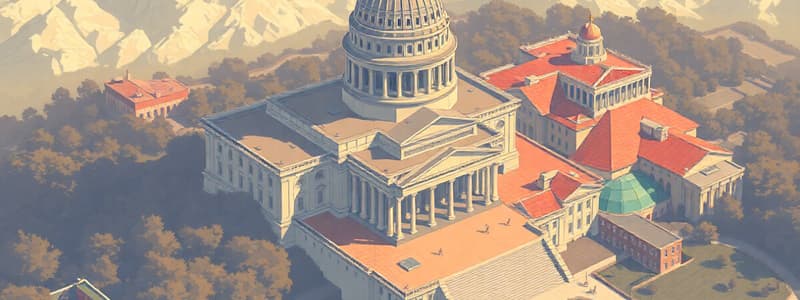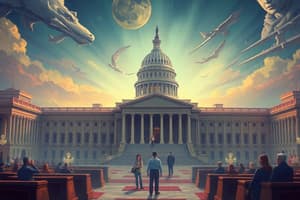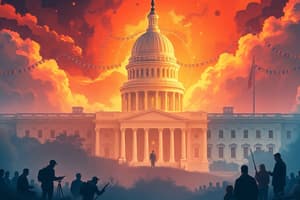Podcast
Questions and Answers
What is gerrymandering?
What is gerrymandering?
- Redrawing district lines to favor one group over another (correct)
- A method for increasing public participation in voting
- A strategy to reduce the number of political action committees
- The process of eliminating ineffective members of Congress
What percentage of PAC contributions typically goes to incumbents?
What percentage of PAC contributions typically goes to incumbents?
- 90%
- 65%
- 85% (correct)
- 50%
Which chamber of Congress has members serving 2-year terms?
Which chamber of Congress has members serving 2-year terms?
- Select Committee
- Senate
- House of Representatives (correct)
- Joint Committee
What is a pocket veto?
What is a pocket veto?
What is the primary function of congressional committees?
What is the primary function of congressional committees?
What fraction of Senators is required to pass a vote for cloture?
What fraction of Senators is required to pass a vote for cloture?
Which of the following is true about the leadership of the Senate?
Which of the following is true about the leadership of the Senate?
Which of the following factors accounts for the difference in the number of representatives from Texas versus Alaska?
Which of the following factors accounts for the difference in the number of representatives from Texas versus Alaska?
What is the purpose of a filibuster in Congress?
What is the purpose of a filibuster in Congress?
Which group is responsible for setting the debate schedule in the House of Representatives?
Which group is responsible for setting the debate schedule in the House of Representatives?
What is a key difference in debate practices between the House and Senate?
What is a key difference in debate practices between the House and Senate?
What is the reelection rate for members of the House of Representatives?
What is the reelection rate for members of the House of Representatives?
Where must all revenue bills originate, and why?
Where must all revenue bills originate, and why?
What is the primary difference between implied powers and inherent powers?
What is the primary difference between implied powers and inherent powers?
What is legislative oversight primarily concerned with?
What is legislative oversight primarily concerned with?
Who has the authority to introduce a bill in Congress?
Who has the authority to introduce a bill in Congress?
Flashcards
Gerrymandering
Gerrymandering
Redrawing voting district lines to favor one political group over another.
Pork-barrel legislation
Pork-barrel legislation
Legislation that includes unnecessary spending to benefit a specific group or region.
Pocket Veto
Pocket Veto
A way a president can kill a bill when Congress is not in session. The president doesn't sign it, and it dies.
Congress functions
Congress functions
Signup and view all the flashcards
Cloture vote
Cloture vote
Signup and view all the flashcards
Filibuster
Filibuster
Signup and view all the flashcards
PAC contributions
PAC contributions
Signup and view all the flashcards
Incumbent advantage
Incumbent advantage
Signup and view all the flashcards
House vs. Senate Representatives
House vs. Senate Representatives
Signup and view all the flashcards
Speaker of the House
Speaker of the House
Signup and view all the flashcards
Senate Majority Leader
Senate Majority Leader
Signup and view all the flashcards
Bill-Killing Rate
Bill-Killing Rate
Signup and view all the flashcards
Congressional Differences (1800s-Today)
Congressional Differences (1800s-Today)
Signup and view all the flashcards
Filibuster
Filibuster
Signup and view all the flashcards
Cloture
Cloture
Signup and view all the flashcards
Bill Introduction (Congress)
Bill Introduction (Congress)
Signup and view all the flashcards
Standing Committee
Standing Committee
Signup and view all the flashcards
House Rules Committee
House Rules Committee
Signup and view all the flashcards
Member Pay (Congress)
Member Pay (Congress)
Signup and view all the flashcards
House Reelection Rate
House Reelection Rate
Signup and view all the flashcards
Legislative Process
Legislative Process
Signup and view all the flashcards
Interstate Commerce Power
Interstate Commerce Power
Signup and view all the flashcards
Revenue Bills Origin
Revenue Bills Origin
Signup and view all the flashcards
Implied Power
Implied Power
Signup and view all the flashcards
Inherent Power
Inherent Power
Signup and view all the flashcards
Expressed Power
Expressed Power
Signup and view all the flashcards
Legislative Oversight
Legislative Oversight
Signup and view all the flashcards
Study Notes
Congressional Structure and Function
- Congress differs from 1800s Congress, having larger staffs dealing with more legislation.
- Pork-barrel legislation involves unnecessary parts of legislation.
- Committees kill about 90% of bills.
- A pocket veto occurs when a bill is neither signed nor vetoed while Congress is adjourned.
- Congress's main functions are lawmaking, oversight, and representation.
- Cloture is a vote to end debate, requiring a specific fraction of Senators.
- A filibuster is intended to block a vote, and ends with cloture.
- Any member can introduce a bill in Congress.
- Most legislative work is done in committees.
- The House Rules Committee sets the schedule for bill votes and debate in the House.
- House representatives' salary is 175,000;Senaterepresentativesalsoearn175,000; Senate representatives also earn 175,000;Senaterepresentativesalsoearn175,000.
- The House's reelection rate is 94%.
Gerrymandering and PACs
- Gerrymandering is redrawing congressional districts to favor one group over another.
- Gerrymandering sometimes occurs during redistricting and is illegal.
- 85% of PAC contributions go to incumbents.
- Differences in representative numbers between states like Texas and Alaska are due to population differences.
- The Speaker of the House leads the House of Representatives, while the Majority Leader leads the Senate.
Congressional Membership and Qualifications
- House: 435 members; minimum age 25; 7-year U.S. citizenship; resident of represented state; 2-year terms; no term limits.
- Senate: 100 members; minimum age 30; 9-year U.S. citizenship; resident of represented state; 6-year terms, with 1/3 up for reelection every 2 years; no term limits.
Legislative Process and Debate
- The legislative process involves introduction, committee review, debate, and presidential action (signing or vetoing).
- The House has time limits on debate; the Senate does not.
- Congress's power to regulate interstate commerce is vast, impacting many aspects of life.
- Revenue bills must originate in the House, aiming to represent the people.
Implied and Inherent Powers
- Implied powers are created by the Necessary and Proper Clause
- Inherent powers are inherent to a government.
Legislative Oversight
- Congressional oversight is continuous review of executive branch actions, ensuring laws are implemented effectively.
Congressional Styles and Issues
- The politico style combines trustee and instructed delegate approaches.
- Minority-majority districts can have a majority of citizens from a minority group.
- Factors like misconduct, turnout, and strong challengers, can affect a member of Congress's election chances.
Studying That Suits You
Use AI to generate personalized quizzes and flashcards to suit your learning preferences.




